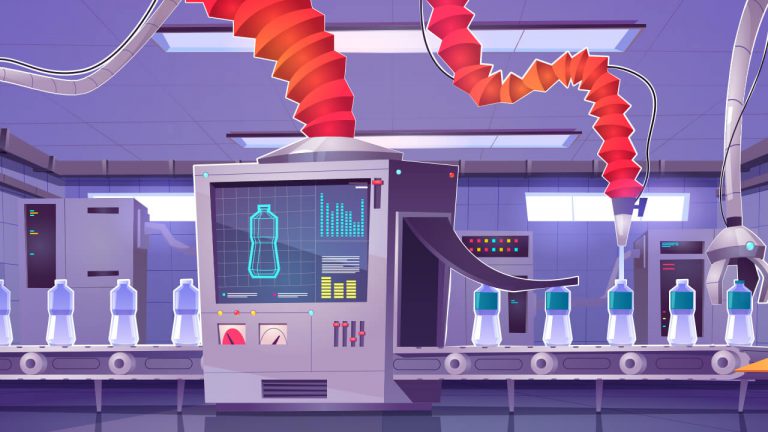How Robotics Empower the Plastics Industry
Whether it is plastic bottles being blow molded into their distinct shapes, or laptops being spray painted with a plastic coating at their place of production, the world within the plastic industry is rife with robotics.
Across the globe, 367 million metric tons of plastics were estimated to have been produced in 2020—and that was in pandemic time, when production decreased from the normal. To keep up with this exponential rate of catering to the thousands of industries that require plastics components, manual labour by itself is untenable.
The logical and natural solution for the industry, for the last several decades, has been artificial intelligence. Here are 4 reasons why robotics inform and improve the plastics industry.
- Flexibility in Minimal Space
The immediate advantage of a robot over a human is their potential to work in tight spaces, minimizing factory space and maximizing the output. The robots nowadays can orient themselves in a variety of angles, with some of them having several joints to work with. The human equivalent in labour would accrue repetitive strain injuries (RSI) on their back and joints just to keep up to a reasonable pace.
- Prevents Occupational Hazards and Injuries
For actions such as welding, blowing, and high-volume sorting ove production lines, the stress on the human posture can be unbearable over the long factory hours, The industry’s standard are six-axis robots, which are programmed to traverse in the x, y, and z planes, mimicking closely—and in faster motions—the human arm, one reason they are ideal for taking over production lines.
- Optimizes the Quality of Work
Due to advances in robot programming tools, many robots used in production lines can track human hand motions and then mimic them at higher speeds. The precision, low error-rate, and speed cannot be replicated by humans, which is why the quality of work tends to outshine any alternative.
- Lends a Competitive Edge
With improved labour costs, speed of production, and low error rate, the companies that adopt large-scale robotics tend to outperform the companies that don’t. Especially important is injection molding, which is preferred by most manufacturers to produce plastic components at high volumes. Profit margins rise in tandem with the regularity at which decision-makers purchase relevant plastics manufacturing robotics.
In the long run, the adoption of robotics in the industry has led to all-round development in all aspects of the industry. There can be no doubt that, in the burgeoning post-pandemic situation, the companies that want to recover lost ground should research the best robotics available for their respective contexts.
Leave a Reply Cancel reply
Recent Posts
- Understanding The Materials That Are Used To Build Plastic Toys
- All You Need To Know About Food-grade Plastics
- A Glance At The Materials That Boost The Performance Of Plastics
- Understanding The Importance Of Exploring New Business Opportunities In The Plastic Industry
- Understanding The Importance Of Investing in R&D For The Plastic Industry
Categories
- 3D Printing
- AIPMA
- Automation
- Automobile Sector
- Bio Plastics
- Environment
- Innovations In Recycling
- Latest Innovations
- Molds & Dies
- News
- Packaging Industry
- Plastic
- Plastic Application
- Plastic Industry
- Plastic Market
- Plastic Myths
- Plastic News From The World
- Plastic Packaging
- Plastic Products
- Plastic Recycling
- Plastic Solar Cells
- Plastic Toys
- Plastic Waste
- Plastic World
- Plastics
- Plastics And Their Applications
- Plastics In Agriculture
- Plastics In Healthcare
- Plastics In Medical Industry
- Plasticulture
- Processing Machinery
- Recycling Machines
- Robotics
- Uncategorized
- Virtual Reality
Archives
- November 2023 (3)
- October 2023 (2)
- September 2023 (3)
- August 2023 (3)
- July 2023 (3)
- June 2023 (3)
- May 2023 (2)
- April 2023 (2)
- March 2023 (2)
- February 2023 (2)
- January 2023 (2)
- December 2022 (3)
- November 2022 (1)
- October 2022 (1)
- September 2022 (2)
- August 2022 (1)
- July 2022 (3)
- May 2022 (3)
- March 2022 (2)
- February 2022 (1)
- January 2022 (1)
- September 2021 (2)
- August 2021 (3)
- July 2021 (4)
- June 2021 (4)
- May 2021 (3)
- April 2021 (2)
- March 2021 (4)
- November 2019 (8)
- October 2019 (8)
- September 2019 (8)
- August 2019 (8)
- July 2019 (8)
- June 2019 (8)
- May 2019 (8)
- April 2019 (8)
- March 2019 (8)
- February 2019 (11)
- January 2019 (8)
- December 2018 (8)
- November 2018 (12)
- October 2018 (12)

